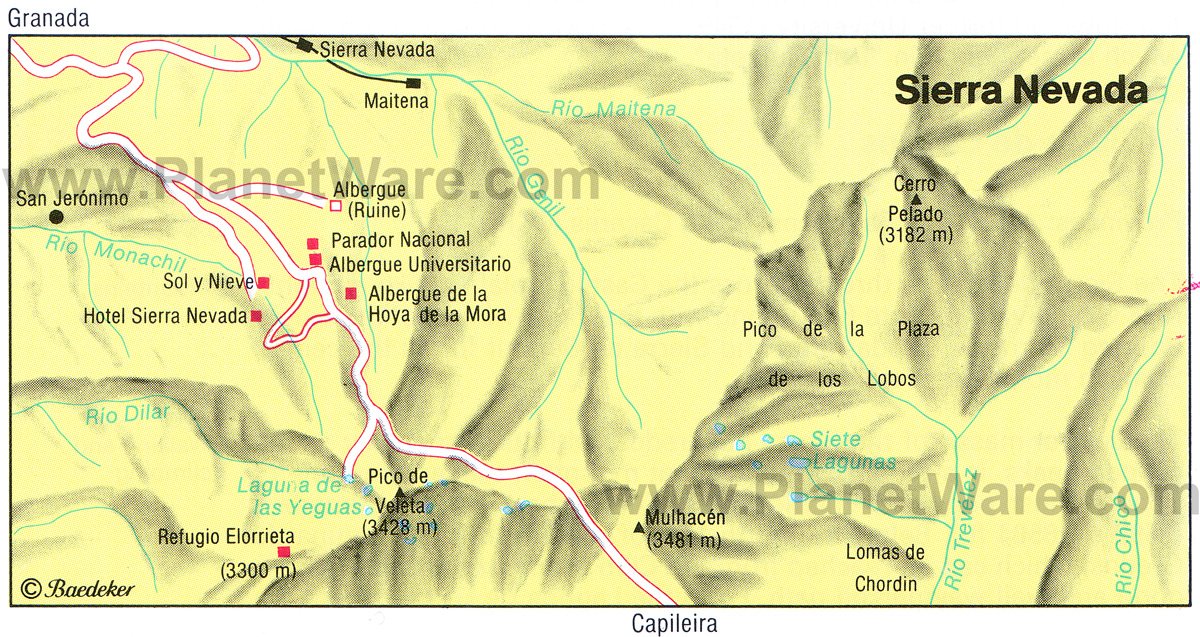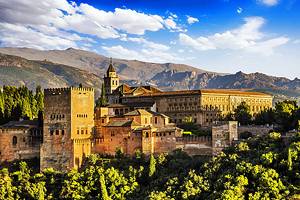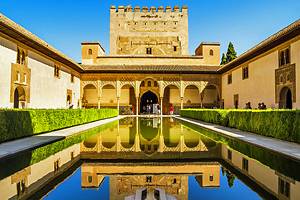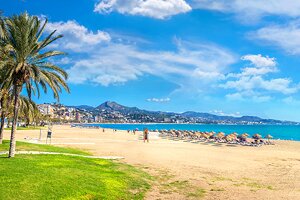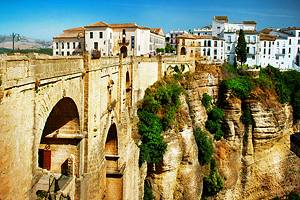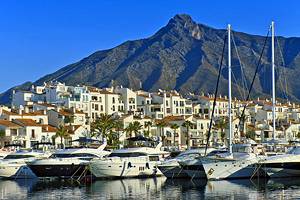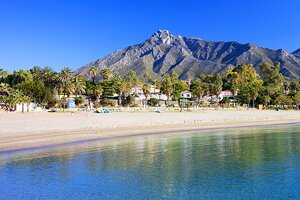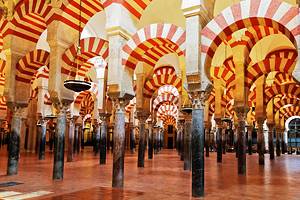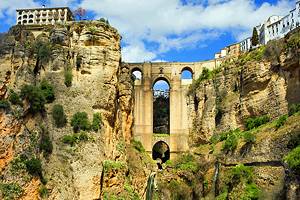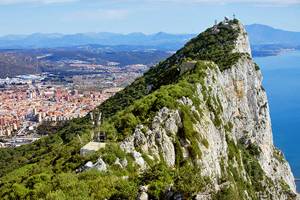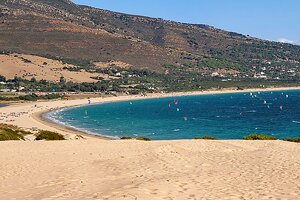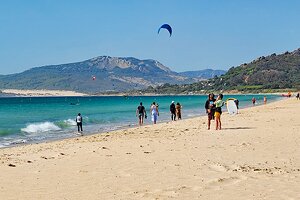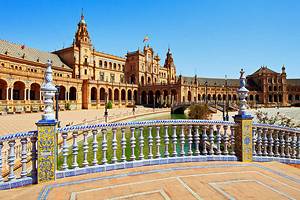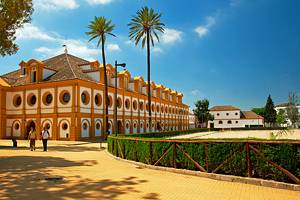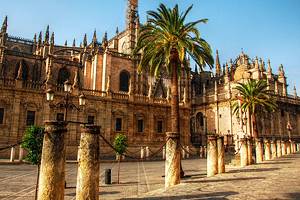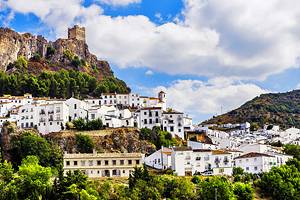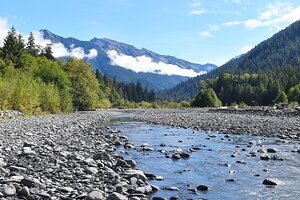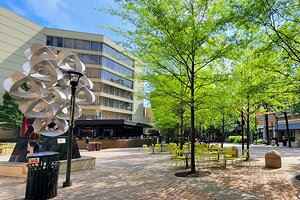10 Top Tourist Attractions in Spain's Sierra Nevada Mountains
Spain's highest mountain peaks, the snowcapped Sierra Nevada mountains soar to heights above 3,000 meters. Protected as a national park and designated as a UNESCO Biosphere Reserve, this expansive mountain range in the Andalusia region extends for 90 kilometers.
Visitors are delighted by the inspiring alpine scenery and the peaceful environment, with its lush vegetation and abundance of freshwater streams.
From November through June, the Sierra Nevada mountains are blanketed with snow. The Pradollano ski resort is just 45 minutes from Granada and has wonderful wide-open downhill slopes. As Europe's most southerly winter sports region, the Sierra Nevada has relatively mild weather and frequent sunny days with perfectly blue skies.
Descending from the Sierra Nevada mountain peaks, Las Alpujarras is an idyllic countryside of wooded rolling hills, verdant valleys, and olive groves dotted with typical Pueblos Blancos (Moorish whitewashed villages). These characteristic towns feature quiet pedestrian lanes, flower-bedecked houses, and small historic churches often converted from mosques. Surrounding the villages are nature trails for mountain hikes.
Plan your travels through this awe-inspiring landscape and learn about the best places to visit with our list of the top attractions in Spain's Sierra Nevada.
- The Route to Pico de Veleta
- The Moorish Charm of Capileira
- Pampaneira: A Whitewashed Alpujarras Village
- Picturesque Mountain Scenery in Bérchules
- The Bohemian Village of Órgiva
- Camino Real de las Hoyas Nature Trail
- Lanjarón: A Famous Spa Town
- The Mountain Village of Trevélez
- Country Village of Bubión
- Pradollano Ski Resort
- Map of Tourist Attractions in Spain's Sierra Nevada Mountains
The Route to Pico de Veleta
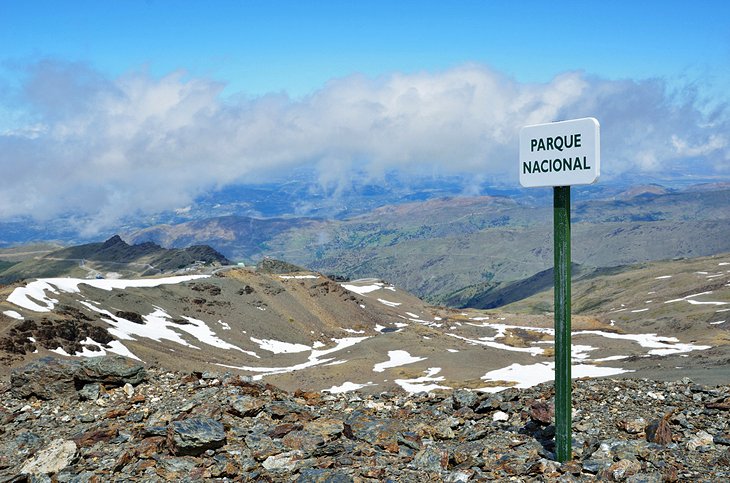
Reaching 3,428 meters, the Pico de Veleta Mountain is the second-highest peak in the Sierra Nevada range after the Cerro de Mulhacén Mountain, which soars to 3,481 meters. The road to the Pico de Veleta is an enchanting trip into the glorious mountain world of the Sierra Nevada.
The journey begins at an elevation of 640 meters at Vega de Granada and climbs at a continuous ascent to 3,392 meters, nearly to the peak of Pico de Veleta, making it one of Europe's highest mountain roads. The route follows a paved road and can be made by bus or by car.
This 35-kilometer journey is best begun in the early morning to avoid driving in the direct sun. A striking feature of the route is the contrast between the lush southern landscape of the Vega de Granada and the snowcapped Sierra Nevada peaks. Warm clothing is advised because of wind and cold temperatures at the top.
The Moorish Charm of Capileira
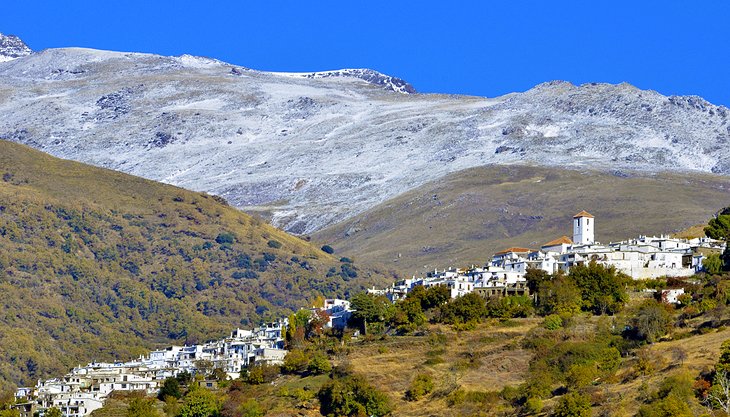
In the wild mountainous region of Las Alpujarras, the village of Capileira stands at 1,436 meters just 37 kilometers from the Pico de Veleta. To arrive here from the Pico de Veleta Mountain, take the narrow road that winds up first around the summit and then descends in hairpin bends to the village.
Capileira is the highest and most remote of the three whitewashed villages in the Poqueira Gorge, an area of beautiful rugged scenery. Built into a hillside, the village has narrow, twisting streets and many freshwater springs running through the town. From almost every spot in the village, the views are exceptional.
Originally under Moorish rule, the village was conquered by the Christians in the early 16th century. The Catholic Monarchs created the Iglesia de Nuestra Señora de la Cabeza (Iglesia Parroquial de Santa María la Mayor) on the site of a former mosque. The current Mudéjar-style church was renovated in the 18th century.
Showcasing the local culture and heritage, the Museo Pedro Antonio de Alarcón (on Calle Mentidero) displays a collection of local crafts and costumes, as well as an exhibition on the 19th-century Spanish author Alarcón.
The village of Capileira is a good base for nature walks and hikes in the gorge as well as up to the Sierra Nevada mountains.
For those seeking accommodations in Capileira, the three-star Finca Los Llanos delights with its spectacular views, outdoor swimming pool, and tree-shaded terrace. Traditional Moorish details, including decorative ceramics and wood accents, define the hotel's rustic Andalusian architecture. The hotel has a restaurant that serves regional cuisine with a modern touch.
Pampaneira: A Whitewashed Alpujarras Village
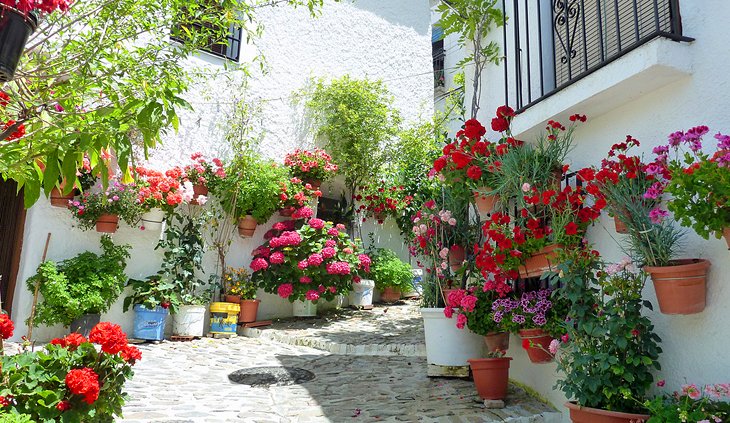
Pampaneira is a typical Moorish whitewashed village of Las Alpujarras, with a rich cultural heritage. Visitors are enchanted by the village's old-world character, with its narrow cobblestone streets and alleyways, peaceful squares, and traditional houses.
The small village of around 300 residents sits on the steep slopes of a scenic river gorge, the Barranco de Poqueira (Poqueira Gorge), along with the other whitewashed villages of Bubión and Capileira. Pampaneira is the lowest elevated of the three villages, resting in the foothills at 1,000 meters.
At the center of the village is a lovely square graced by the Iglesia de Santa Cruz, a 16th-century Mudéjar church with a wood-panel ceiling and gilded altarpiece from the 17th and 18th centuries.
The town square has a handful of cafés and restaurants, plus a few traditional craft shops. A highlight for many tourists is Abuela Ili, an artisanal chocolate factory and boutique.
In the peaceful landscape surrounding Pampaneira is the O Sel Ling Buddhist monastery. Fittingly placed in this remote environment, the monastery is devoted to the Buddhist values of meditation and seclusion.
Picturesque Mountain Scenery in Bérchules
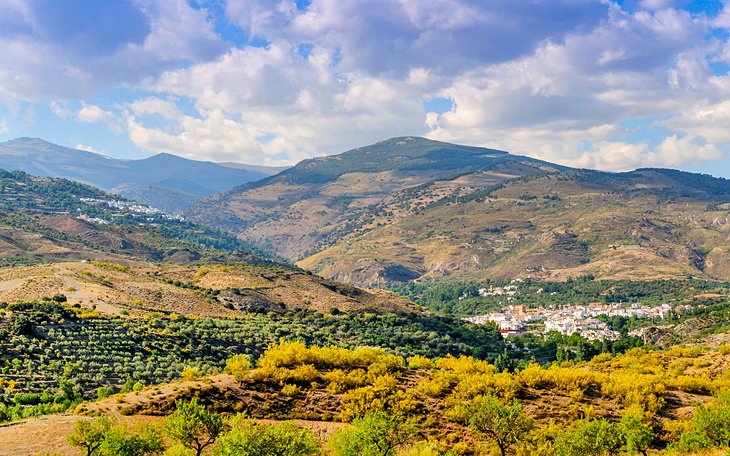
This picturesque hilltop village is perched at an altitude of 1,320 meters in the Alpujarras region, overlooking the dramatic gorge of the Guadalfeo River (a good place for trout fishing). The Sierra Nevada mountains provide a striking backdrop.
The name of the village comes from the Arabic word "vergel" meaning pasture, and the area still has lush green pastures where goats, sheep, and cattle graze. Cow bells are heard as the animals move about, and the chirping of little birds is another familiar sound.
The countryside also encompasses fertile farmland of cherry, apple, and peach orchards; fields of tomatoes, strawberries, and raspberries; and ancient chestnut trees.
Bérchules draws many visitors for its things to do outdoors, including hiking, biking, and horseback riding.
For a pleasant scenic walk, take the path lined by mulberry trees that leads to an old Moorish arch. This is a popular spot for picnics on sunny days.
A great base for an outdoorsy vacation, the two-star Hotel Los Bérchules provides cozy accommodations with fabulous views of the rural landscape. This rustic Andalusian lodge has an outdoor swimming pool and a restaurant that serves traditional cuisine of the Alpujarras region. Every room features a balcony, so that guests can admire the sweeping vistas.
The Bohemian Village of Órgiva
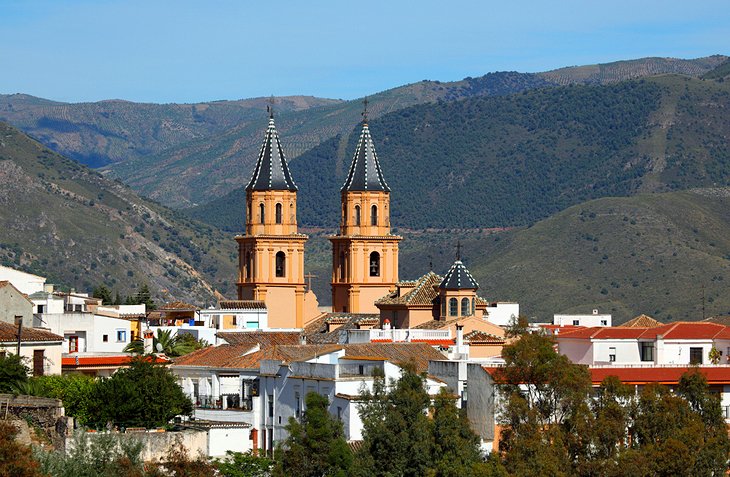
Nestled in the fertile valley of the Guadalfeo River, Órgiva is 20 kilometers from Capileira and is the largest town of Las Alpujarras. Visitors come for the beautiful mountain views, peaceful setting, and mild climate. The countryside around Órgiva is covered with groves of olive trees as well as orange and lemon orchards.
The village has an impressive 16th-century church, the Iglesia de Nuestra Señora de la Expectación, featuring a twin-towered Baroque facade. The church possesses a sculpture of Christ that is considered to be the work of the renowned artist Juan Martínez Montañés.
Another noteworthy attraction is the Palacio de los Condes de Sástago (Palace of the Counts of Sástago), a 16th-century aristocratic palace that was home to the Great Captain Don Gonzalo Fernández of Córdoba.
Nowadays, the town of Órgiva is better known for its artsy bohemian ambience. The main street near the church has many atmospheric cafés. Tourists will also appreciate the town's choice of hotels and other lodging options.
The Casa Jazmín is a highly rated boutique accommodation with stunning mountain views, a delightful garden, and outdoor swimming pool. The hotel has only four guest rooms; each is decorated differently in charming Andalusian style.
Camino Real de las Hoyas Nature Trail
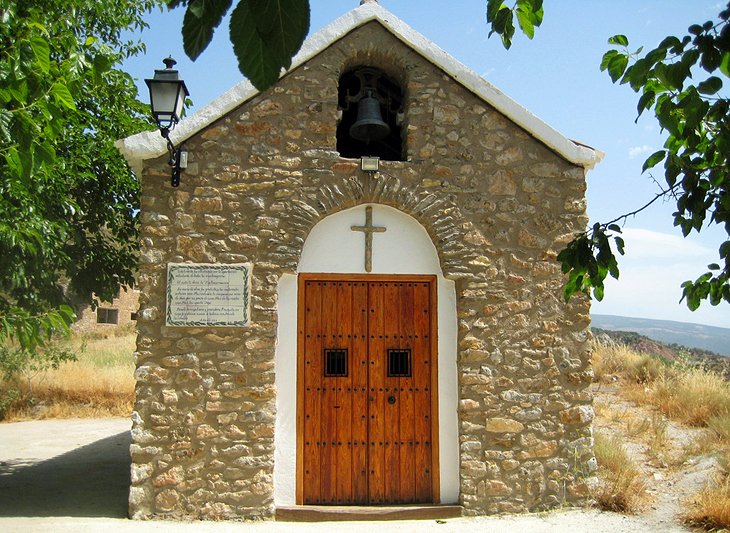
The tiny neighboring villages of Yegen and Mecina Bombarón are surrounded by a pristine countryside that is an excellent place for hiking and nature walks. Typical of Las Alpujarras villages, Yegen and Mecina Bombarón are made up of Moorish-style whitewashed houses clustered around historic churches.
In Yegen, the Iglesia del Dulce Nombre del Niño Jesús is a Mudéjar-style church converted from an old mosque. The interior is notable for its simplicity and serenity.
In Mecina Bombarón, the 18th-century Iglesia Parroquial de San Miguel Arcángel was built to replace a 16th-century church destroyed by the Moors. As is common in Andalusia, this church has Islamic-influenced design details including Arabic tile work.
A path lined with ancient oak trees, the Camino Real de las Hoyas (Royal Road of the Hoyas) unites both villages. Along this five-kilometer trail, hikers will come across an old bridge, believed to be of Roman origin, that linked Almería with Granada; the ancient bridge lies below a modern transit bridge, offering a stunning contrast of architectural styles.
The Camino Real de las Hoyas route traverses the varied landscape of the Sierra Nevada, full of diverse vegetation and wild animals such as mountain goats and wild boar.
Several little hermitage chapels are found in Mecina Bombarón, and the nearby community of Montenegro. These small chapels hold shrines to sacred figures and are important pilgrimage sites.
Lanjarón: A Famous Spa Town
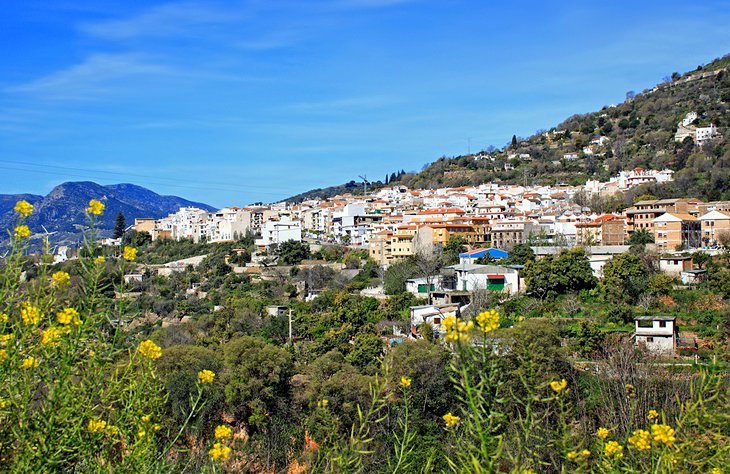
With its pure mountain air and gorgeous scenery, Lanjarón is the gateway to the Alpujarras region at its western edge. The countryside surrounding Lanjarón is a rugged landscape with hillsides full of wildflowers.
The town is famous for its natural spring; the prized mineral spring water is sold all over Spain. Lanjarón's thermal baths are also known for their healing effects, and the town's spa has attracted visitors for centuries.
Established in 1760, the Balneario de Lanjarón offers spa treatments, thermal baths, and medicinal mineral-water pools. This prestigious destination also includes four-star accommodations with contemporary-style guest rooms, a concierge, fitness center, tennis court, and a restaurant that serves healthy organic Mediterranean cuisine.
The town is well designed for tourists, with a wide variety of hotels and restaurants. Above the village, on a rocky outcrop, are the ruins of a Moorish castle, where the Moors were defeated by King Fernando's Christian army.
The Mountain Village of Trevélez
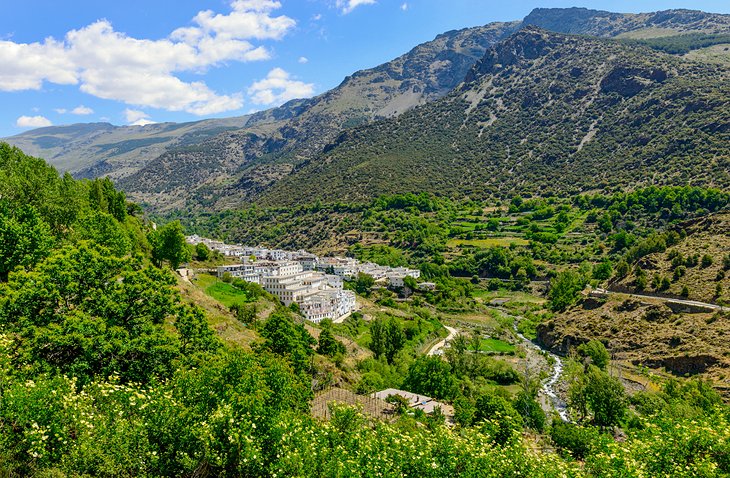
Set in a dramatic river valley, the village of Trevélez is the highest in mainland Spain at 1,476 meters. This tiny mountain village is home to a community of around 800 residents and is divided between three barrios: bajo (low), medio (middle), and alto (high).
The Barrio Bajo (Lower District) area of Trevélez appeals the most to tourists. This lively neighborhood has many artisan boutiques, restaurants, and hotels.
Trevélez is a wonderful base for exploring the Parque Nacional de Sierra Nevada. This national park boasts 15 mountain peaks that soar above 3,000 meters, with the Mulhacén mountain peak at the highest elevation (3,482 meters). Visitors enjoy hiking, mountain biking, skiing, mountaineering, and other outdoor activities at the Sierra Nevada National Park.
Country Village of Bubión
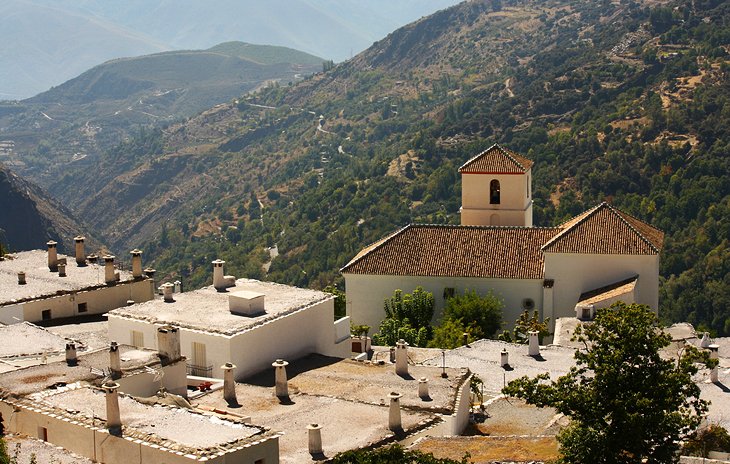
This sleepy country village lies halfway between Capileira and Pampaneira in the Poqueira Gorge. The little hamlet of whitewashed houses is surrounded by the Alpujarras foothills and snowcapped Sierra Nevada mountain peaks. Magnificent views await at every turn.
The village has several artisan craft shops and an ethnography museum, the Casa Alpujarreña, which presents a traditional Alpujarran peasants' house with the original decor.
Bubión is a great starting point for taking long-distance nature walks, hikes, and horseback riding trips.
Pradollano Ski Resort
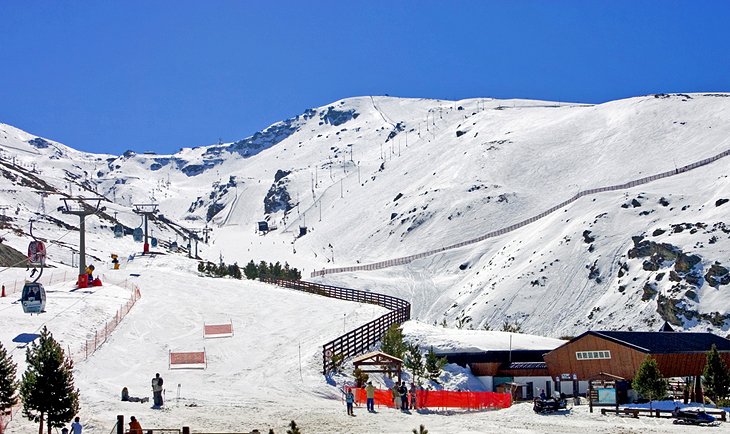
The winter sports resort of Pradollano, previously named Sol y Nieve (which translates to "Sun and Snow") offers excellent powder snow and brilliant sunny days. This ski resort prides itself on the amount of sunshine it receives each year and on being the most southerly ski resort in Europe with relatively mild weather.
The Pradollano ski resort is at an altitude of 2,100 meters to 3,282 meters and has an extensive system of chairlifts and gondolas. Most of the resort's ski terrain is suitable for beginner and intermediate skiers. The ski season runs from late November or December to April or May.
The area has all types of tourist accommodations from luxury resorts to basic hotels, charming chalets, and rustic mountain huts. The Pradollano ski resort is about 38 kilometers from Granada.
Map of Tourist Attractions in Spain's Sierra Nevada Mountains
More Related Articles on PlanetWare.com
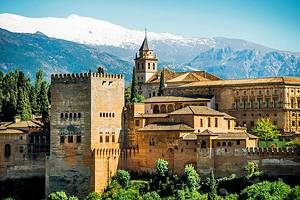
Nearby Treasures in Granada: Bordering the Sierra Nevada Mountains is Andalusia, southern Spain's most quintessential region. The closest tourist destination of Andalusia is Granada (a 90-minute drive from Capileira), renowned for its splendid Alhambra palaces. The UNESCO-listed Alhambra complex is famed for its luxuriant gardens filled with flowing fountains, fragrant orange trees, and vibrant roses.
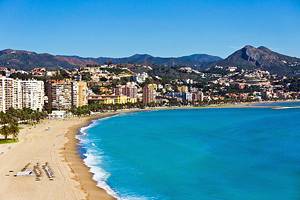
Other Highlights of Andalusia: Slightly further afield are other amazing travel destinations including the dramatic cliffside town of Ronda (a three-hour drive) and Córdoba (a 3.5-hour drive), which has a UNESCO-listed 8th-century mosque. The old Mediterranean port town of Málaga (a two-hour drive) boasts beautiful seaside scenery, an old Moorish castle, and fabulous art museums. Surrounding Málaga are fun-loving beach resorts along the Costa del Sol.
